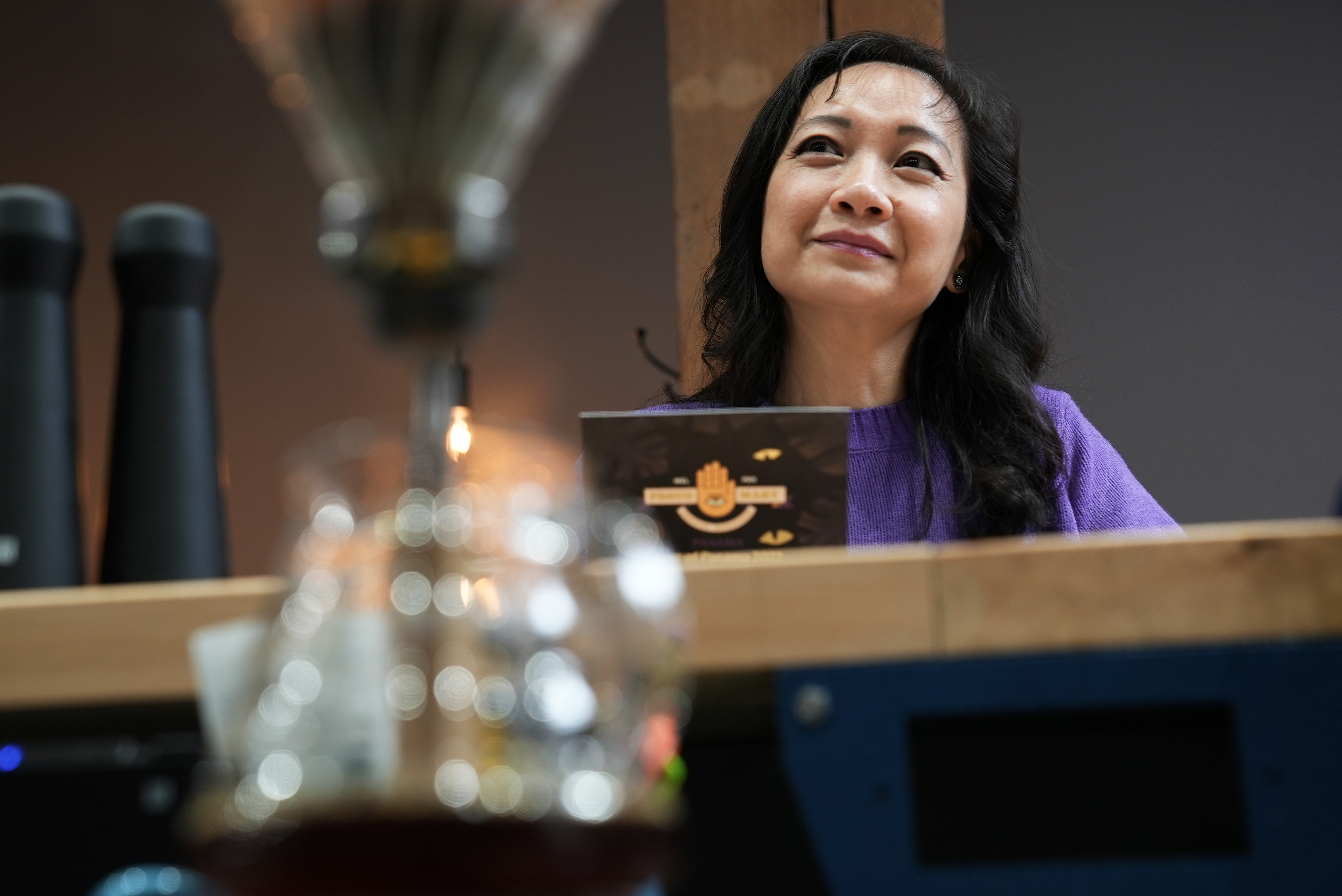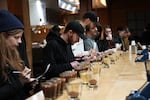
Phuong Tran waits at the bar at Proud Mary Café in Portland, Ore., on Feb. 12, 2023, for her free cup of Black Jaguar Geisha coffee. Tran, who is the owner of Lava Java coffee shop in Ridgefield, Wash., won the Golden Ticket at Proud Mary’s cupping competition for a chance to drink this special roast, priced at $150 a cup.
Arya Surowidjojo / OPB
On a bustling Sunday morning, Proud Mary Café in Northeast Portland is packed with people. There is a line out the door for brunch, but a small group gathered by Phuong Tran has come this morning to taste one very special cup of coffee.
“I really wanted to share this cup of coffee because it’s so rare,” said Tran. “Not very many people have a chance to drink it, so that’s why I was like: ‘I can’t just drink it by myself. That’s not fair!’”
This isn’t just any coffee, it’s an ultra-premium, natural processed Geisha that recently sold at auction for $2,000 per pound, called Black Jaguar. This coffee was grown on a tiny farm in western Panama owned by the Hartmann Estate. Last year, it won Best of Panama, a specialty coffee competition that gives a platform for local coffee producers to showcase the best of the best.
In that competition, coffees are tasted and scored by a panel of international judges using a standardized scoring system that evaluates everything from acidity and sweetness to body and fragrance. While not the only way to evaluate coffee, these cupping forms help set a benchmark to define which coffees are or are not considered “specialty.” Specialty coffee is defined as any coffee that scores above 80 points on a 100-point scale. The Hartmann Estate’s Black Jaguar Geisha scored an incredible 96.5, securing a first place win and the highest price at auction.

Local baristas and coffee aficionados participate in a cupping competition at Proud Mary Café in Portland, Ore., on Feb. 3, 2023, for a chance to win a cup of Black Jaguar Geisha from the Hartmann Estate in Panama. The award-winning roast sold at auction for $2,000 a pound.
Arya Surowidjojo / OPB
Some of that auction lot was bought by Australian-based Proud Mary Coffee Roasters, who have had a relationship with the Hartmann Estate since 2011.
“We already were set to purchase a fair amount of their Geisha already along with a whole bunch of other varietals and lots from [the Hartmann] farm,” said Matt Lounsbury, senior vice president at Proud Mary Coffee Roasters. “But we figured we might as well partake in that auction lot [and] based on what we paid for it, we had to offer it by the cup.”
With two U.S. locations — one in Portland and one in Austin, Texas — there were less than a dozen cups up for grabs at each Proud Mary Café. Each with a price tag of $150 for a single cup.
And Phuong Tran was the last person in Portland to taste the Black Jaguar Geisha.
“It was released on Monday [and] everybody came in and bought it,” she said. “But they had to reserve the one for the ‘golden ticket’.”
A week before the coffee’s release, Tran had attended a coffee tasting at Proud Mary and won a golden ticket to try the exclusive coffee for free, something that made Lounsbury, laughing, say: “You can’t make this up!”
That’s because Tran is not just a coffee connoisseur, but an icon in her own right in the Pacific Northwest coffee scene. Since 2002, she’s owned and operated Lava Java in Ridgefield, Washington, and, in 2005, became the United States Barista Champion. Her ticket was one of two in Oregon. The other was sent out randomly with a purchase of coffee online, alá “Charlie and the Chocolate Factory.”

The Golden Ticket and Black Jaguar Geisha flyer from Proud Mary in Portland, Ore.
Arya Surowidjojo / OPB
The remaining cups of Black Jaguar were snatched up quickly by eager coffee connoisseurs. But while the $150 price of those cups of coffee was ultimately determined by auction, Proud Mary Café’s decision to purchase it was more philosophical.
“One of the things that’s really important to us is to raise awareness around how little coffee producers make for their coffee,” he said. “There’s still a problem with how much people get paid. So for us, how we source coffee is always with the producer in mind.”
Lounsbury said that, in his two decades in the coffee industry, a lot has changed, including what consumers are willing to pay for coffee.
“In the early days, it might have been 10 bucks for a bag of swill, and that was high end,” he said. “Now people don’t bat an eye at $12, $15, sometimes $20 a bag.”
But in terms of what producers make for their coffee, Lounsbury says it’s still very little.
“If you look at the c-market for coffee, it’s still not very far north of a dollar per pound,” he said. “And it’s been that way since I got into this industry 20 years ago … that’s terrible.”
The commodities market, or c-market, is used to value everything from crude oil to corn. But prices are primarily influenced by supply and demand, rather than quality.
“The definition of commodity is a product that is produced every single time the same,” says development economist Vera Espíndola Rafael. But, she points out, “[coffee] is not a commodity, it’s a crop.”
Espíndola Rafael says 85-90% of all coffee is produced by small holders. So even though coffee is never produced in bulk, at some point in the supply chain, it begins to be bought in bulk.
After years of coffee economics research across Latin America, Espíndola Rafael joined Azahar Coffee Company in Mexico City as its director of strategic initiatives. She’s helped develop a tool called the Sustainable Coffee Buyers Guide, with the goal of shedding more light on what it actually costs to grow coffee.
Companies buying coffee can input the price they pay for raw beans and the tool calculates that price into one of four tiers related to the livelihood of producers: poverty price, legal price, living price, and prosperous price. It’s a way to help coffee buyers truly understand the cost breakdown and also to encourage a shift in buyer’s minds.
“People still say it’s hard to convince buyers,” said Espíndola Rafael. “You’re damn straight it’s hard. And you know what’s also hard? The poverty that these producers are living in.”

A graphic from development economist Vera Espíndola Rafael shows a tiered price breakdown to buy unroasted green coffee in different regions of Colombia. The four tiers correlate to the livelihood of coffee producers and were created with a tool she designed called the Sustainable Coffee Buyers Guide.
Courtesy of Vera Espíndola Rafael
But the price per cup doesn’t have to be out of reach for an average consumer, or climb as high as $150. Espíndola Rafael points to an exercise they did with a café in New York City, where they asked the retailer to adjust their cost per cup of coffee to $3.27 to reflect what would be the legal wage paid to a producer from a specific region in Colombia. The cafe agreed, saying the difference was not much higher than what they already charged, and was something customers were willing to pay — especially if it guaranteed a certain wage to the people growing the coffee.
“I do believe in the power of the consumer,” she said. “One of the things that I would encourage consumers to ask is simply: ‘Do you know how much the producer was paid for this coffee? And do you have a reference point to find that?’”
Matt Lounsbury, from Proud Mary Café, also argues that paying attention to the price we’re willing to pay for coffee is important to the long-term sustainability of the coffee market. From picking to processing, growing coffee is labor intensive, and the ongoing climate crisis has led to widespread drought and disease, making it a risky financial endeavor. Similar to farming in the United States, children of coffee farmers often don’t want to inherit the farms.
“There’s no money in it,” said Lounsbury. “So they’re just letting it go or they’re turning it into another more cash oriented-crop.”
Ironically, this all comes at a time when coffee drinking has reached an all time high. Americans now drink coffee more than any other beverage, including tap water. Coffee has become integral to our lives — no matter which side of the supply chain you are on.

